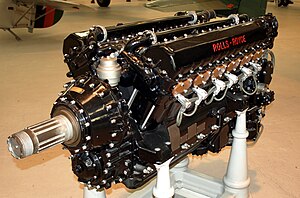Rolls-Royce Kestrel
| Kestrel | |
|---|---|
 |
|
| Rolls-Royce Kestrel XVI at the Royal Air Force Museum Cosford | |
| Type | Piston V-12 aero engine |
| Manufacturer | Rolls-Royce Limited |
| First run | Late 1926 |
| Major applications |
Hawker Hart Miles Master |
| Number built | 4,750 |
| Unit cost | £2,051 (1934) |
| Developed into |
Rolls-Royce Goshawk Rolls-Royce Peregrine |
The Kestrel or type F is a 22-litre (1,342 Cu In) 700-horsepower (520 kW) class V-12 aircraft engine from Rolls-Royce, their first cast-block engine and the pattern for most of their future piston-engine designs. Used during the interwar period, it provided excellent service on a number of British fighters and bombers of the era, such as the Hawker Fury and Hawker Hart family, and the Handley Page Heyford. The engine also sold to international air forces, and it was even used to power prototypes of German military aircraft types that were later used during the Battle of Britain. Several Kestrel engines remain airworthy today.
The Kestrel came about as a result of the excellent Curtiss D-12, one of the first truly successful cast-block engines. Earlier designs had used individually machined steel cylinders that were screwed onto a crankcase, whereas the cast-block design used a single block of aluminium that was machined to form cylinders. The result was both simpler to build as well as lighter and much stronger, requiring only an investment in new machining equipment.
The D-12 was one of the most powerful engines of its era, and continued to exchange records with other contemporary high-power engines. No British company could offer anything like it, and when Fairey imported 50 of the type (renaming them as the Fairey Felix) the Air Ministry had enough and ordered Napier and Rolls-Royce to start work on cast-block engines of their own.
Arthur Rowledge, one of Napier's chief engineers and the designer of the Napier Lion engine, became fed up with management and left for Rolls. In this one move any Napier design effort ended while Rolls' received a boost. Applying every known advance since the D-12 was introduced, Rowledge designed the new engine to use supercharging at all altitudes, allowing it to outperform naturally aspirated engines by as much as they were willing to increase the boost pressure.
...
Wikipedia
